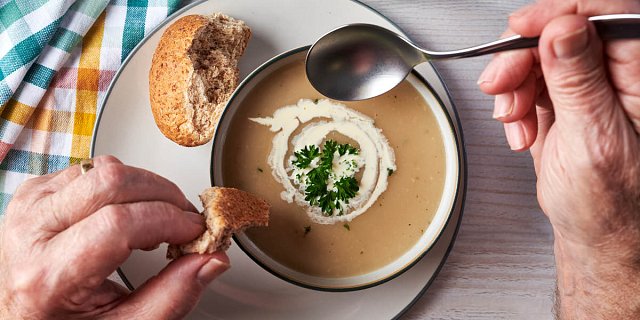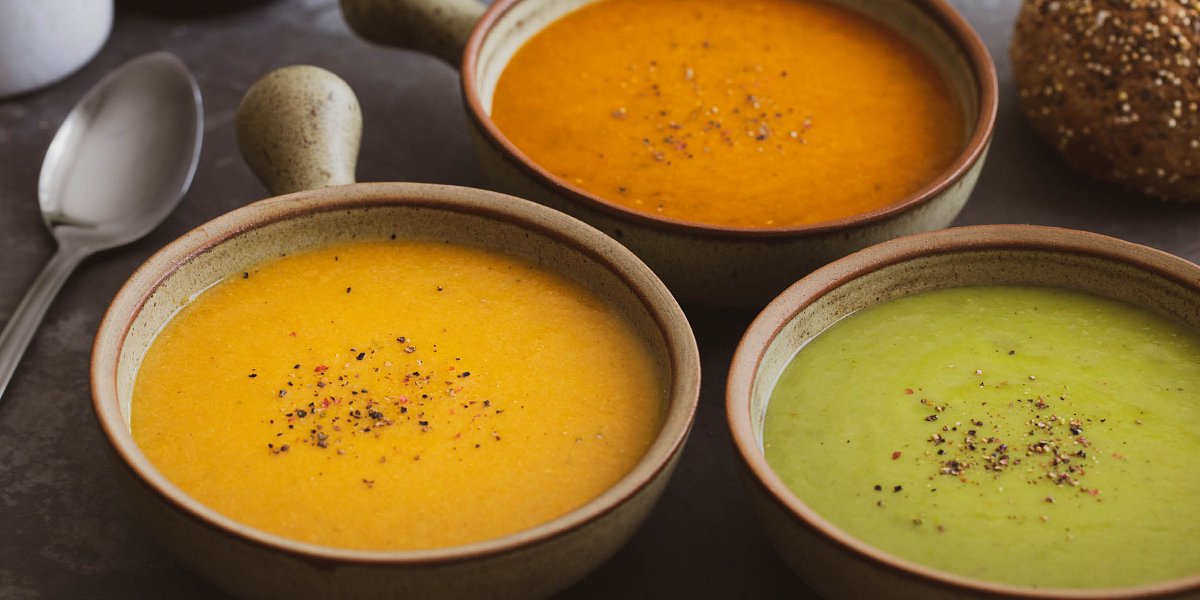Top tips for your soups and snacks menus
It’s feeling decidedly wintry – tuck into our guide to hearty soups and snacks to tap into the cosiness of the season

We’re sure that, over the months and years, you’ll have put your own personal stamp on your menus, but however creative you like to be, we know there will be some cross-over from home to home (no, we’re not just talking about fish Friday). Enter soup. From meat-eaters to vegans and summer to winter, a hearty bowl of minestrone or cream of tomato is undeniably a menu staple.
As well as being easily tweaked for taste and packed with all things good for us, soup is, when portioned correctly, a way of stimulating appetite before a main meal and a useful tool to encourage those who are unwell to eat, says Brian Lane, executive chef at Hallmark Care Homes.
“With home-made soup in particular, you can control the texture, colour and consistency, managing the amount of salt and sugar used,” Lane says. “You can also omit any ingredient that might impact on a resident’s intolerance. They’re more cost effective and nutritious, containing more vitamins, minerals and fibre.”
Tinned varieties still have a role to play, though, he says, and are often popular with residents looking for a light night-time snack or a familiar brand. And when it comes to top flavours, cream of tomato, cream of mushroom, vegetable and carrot and coriander always go down well, he says.
At care catering company White Oaks, which is part of the Compass Group, account lead Felicity Townsend agrees that soups are an important part of residents’ diets. “We serve soup every single day on our menus to residents across our homes, mainly as part of our supper service,” she explains. “We see some residents opting for soup as a meal itself, when they do not want a bigger dish and others choose to have soups to complement their larger meal, so it serves as a starter or a side dish.”

Mushroom soup from Premier Foods
Chefs there choose to cook soups from scratch, with leek and potato, carrot and coriander and cream of tomato often on the menu. “One of the great things about our soup options is that we can flex the recipe, to cater for specific needs – for example we can add cream for those needing a calorie-rich diet, we can make vegetarian versions very easily, plus they can be topped with crunchy croutons or a sprinkling of cheese to add texture or flavour,” she says. “It’s also easy to serve them with some crusty bread, fluffy soft roll or sandwich, so we really can tailor the options to meet very specific requests and needs of residents.”
Being able to tweak your recipes is a tick in the pros column of making soups in-house, but there are others – soups also provide an easy way to use up leftover produce, cutting down on waste.
“You must create a good impression when marketing a care home to potential residents and their families and nothing does this more than a potful of bubbling fresh soup, along with the smell of freshly baking bread,” adds Gareth Newton, BGL Rieber managing director. “But making your own soups is more than about selling. The shortage of skilled chefs and cooks means care homes need their catering equipment to do more of the work. And there is no more ideal equipment solution – given the current energy cost crisis – than choosing to use the most labour and energy efficient equipment on the market. A self-stirring mixer cooking kettle such as the Metos Combi Kettle gives care home caterers as many options as they want for soup and snack making.”
From high-protein chicken noodle to fibre-filled Tuscan bean, combi kettles can take on any soup recipe, he says, and take on the stirring and base browning, which means they can be put to use by both chefs and team members with kitchen hygiene training.

Ready, set, go
Making soups from scratch might be the goal, but we know in busy and often stretched kitchens, relying on ready-made products can be the only way of offering choice. “Fresh soups are great if you have sufficient staff hours and the right ingredients on hand, however good quality dried soups are a useful standby, providing a warm comforting meal which is quick to prepare and can be adapted to residents’ needs,” says Sarah Robb, foodservice marketing manager at Premier Foods. “Classics such as mushroom, chicken and tomato are sure-fire winners. Often a good source of nutrients, creamy soups are a satisfying, filling option for residents, eaten a mealtimes or drunk at teatime.”
Premier has fortified four of its Batchelors classic dried soups with vitamins D and A, inspired partly by research which pointed to lower levels of both vitamins in people living in care settings. It has also launched a Souper 7 Benefits Pack, which provide care chefs with advice on fortification in soups, covering hydration, bones, muscles, skin, vision, teeth and immunity.
“As people get older, health conditions can lead to a lack of appetite,” she says. “Soup can be a comfort and is easy to digest. With a limited repertoire, it’s even more important to pack nutrients into soups, however, and the right balance is key. Alongside the launch of Batchelors fortified dried soups, we worked with a leading dietitian and doctor to create a nutrition fact pack to help care caterers meet the nutritional needs of residents.”
With a chill in the air, Halloween now behind us and Christmas firmly on the horizon, now is the perfect time to be thinking about the warming benefits of soup. After all, what’s more soothing than a steaming bowl of soup and crusty roll on a wintry day? “Soup is a comforting and familiar option for all,” agrees Mary Wedge, business development manager at Anglia Crown. “We believe that any soup offered to residents should have that smooth, homemade feel, so here at Anglia Crown our Crown Choice range offers a number of soups that are predominantly produced from natural ingredients in our Essex production kitchen.
“With a range of nine soups, there is plenty of choice, all of which offer warming colours and a smooth finish, something that is important in the care setting. Each comes in a pack size of eight portions in either chilled or frozen format.”
Its dietitian Ruth Smith says almost 80% of the range meets the British Dietetic Association Nutrition and Hydration Digest guidelines and adds that soups can be used as part of a finger food menu when served in a cup, with bread rolls for dipping.
Snack attack
We all love a snack, don’t we? The ones we fancy – and need – might vary as we go through life, but, whether they’re used as another avenue to up nutritional intake or keep residents full during the day, a good roster of snacks is essential for care homes.
At Hallmark, Lane says teams regularly offer crudités and dip (they’ll usually blanch vegetables to make them easier to eat), fresh fruit, protein and calcium-rich pastries, oily fish toasts or mini scones and muffins.
And Townsend agrees that snacks are an integral part of the catering team’s work. “We have an alternative menu of sweet and savoury snacks which ranges from jacket potatoes, cheese and biscuits and savoury pastries or omelettes to sweet treats and fresh fruit platters,” she says, adding: “As part of our daily routine, we offer refreshments to residents and this is often a social time when residents and their visitors come together. I love it when we tailor our snacks to mark a specific celebration and it’s great to see our chefs get really creative, which residents enjoy and the food and drink brings us all together.”
Whether you’ve been waiting for winter or already have an eye on next summer, the colder days and early nights provide the perfect chance to make sure your soups and snacks are on point: think comforting creamy chicken or hearty pasty bites to reflect the cosiness of the season.

Recipe: Pork, chicken and chorizo sausage rolls
This recipe, from Hallmark Care Homes, makes for 32 sausage rolls – a perfectly cosy treat as the festive season nears.
Ingredients
400g sausage meat
300g finely-chopped chicken breast
150g finely-chopped and cooked chorizo
2 puff pastry sheets, 500mm by 125mm
1 egg
Method
- Mix together the sausage meat, diced chicken and chorizo and spoon into a disposable piping bag. Cut the end to roughly 25mm in diameter.
- Lay out the two strips of puff pastry and pipe one line of the meat mixture off centre of each sheet.
- Dampen the edges of the puff pastry with a little water and fold the pastry over the top of the sausage meat and create a seal.
- Crimp the edge of the pastry and score at an angle at the top with a knife. Brush with the egg wash and cut each length into 16mm by 35mm.
- Place the sausage rolls onto a baking sheet lined with parchment and rest in the fridge for 20 minutes before baking.
- Bake the sausage rolls at 180°C for 20 minutes.
Soup top tips
Why not try executive chef Lane’s top tips for adding a fresh twist to your soup menu?
- Add croutons for texture – use brioche, which is softer than standard bread, and once cooked also adds more calories.
- Serve croute de flutes or cheese straws alongside soups, adding different textures and extra calories.
- Use fresh herbs (or herb oils) for flavour, colour and nutrition.
- Try adding deep-fried halloumi or feta croutons for something different.
- Turn soup into more of a meal with ravioli or gyoza dumplings.
- Stir warm cream or a liaison (egg yolk and cream) through soup to enrich the dish and give a better mouth feel.








